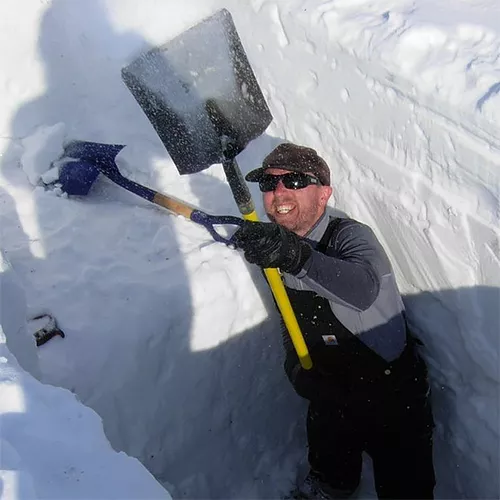Memoriam written by Andrew Barrett, NSIDC
Andrew (Drew) Slater was an exemplary scientist whose research interests spanned a wide range of fields: land-surface modeling, permafrost, snow, hydrology, and data assimilation. He made significant impacts in all these fields. He was a complete scientist, combining theory, modeling, and fieldwork. Slater had a keen intellect and pursued excellence in his work, which he also expected from others. He was ready to provide thoughtful criticism at meetings and in the review process, always with the intent of getting others to “lift their game” and push science forward.
Originally from Sydney, Australia, Slater cut his scientific teeth as a graduate student examining parameterizations of snow schemes in land models as part of the Project for the Intercomparison of Land-Surface Parameterization Schemes (PILPS) Phase 2(d) project. His highly cited 2001 paper reporting this work not only compared snow schemes used in land models but also identified causes of the differences between these schemes. After completing his Ph.D. in 2003, Drew shifted his attention to improving streamflow forecasting in snow-dominated basins. He published papers on ensemble data assimilation, a critical examination of snow reconstruction methods, and a compilation of solar radiation observations from mesoscale observing networks in the United States.
Drew is perhaps best known for his work on improving representation of Arctic land processes in models. In 2005, along with Dave Lawrence, Drew published a paper highlighting the projected degradation of near-surface permafrost. While this projection was based on output from a model with good representation of frozen soil physics, it highlighted shortcomings in land models. Slater set about not only trying to improve land models but also developing benchmarks to compare modeled frozen soil processes.
Slater pursued science as an endeavor rather than a career. He was always curious, always searching for interesting problems to work on, and always keen to communicate his work to everyone, from elementary school children to his colleagues. In the 2010s, he became interested in seasonal forecasting of sea ice. Using his knowledge of forecasting, data assimilation, and statistics, he developed a simple but skillful sea ice prediction model that performed as well as, if not better than, contemporaneous physically-based sea ice models. Keen to communicate this work to others, he developed web pages to present the results of this work to the scientific community and general public, to explain the results, and to demonstrate the skill and uncertainty of the model. He also developed a popular set of web pages to provide near real-time snow depth for the western United States. This pro-bono work was mostly driven by his passion for snow and skiing, as well as by a desire to provide information about the best-skiing to his fellow powder hounds. Slater passed away on September 9, 2016, in Boulder, Colorado. He was 44 years old.
His contributions to science and to communicating science are appreciated by colleagues and members of the general public. For additional insights on his contributions, see Andrew Slater (1971-2016) in Eos.
References
Lawrence, D. M., and A. G. Slater. 2005. A projection of severe near-surface permafrost degradation during the 21st century. Geophysical Research Letters, 32(24): L24401. doi:10.1029/2005GL025080.
Slater, A.G. 2016. Surface solar radiation in North America: A comparison of observations, reanalyses, satellite, and derived products. Journal of Hydrometeorology 17(1): 401-420. doi:10.1175/JHM-D-15-0087.1.
Slater, A.G., and D. Lawrence. 2013. Diagnosing present and future permafrost from climate models. Journal of Climate 26, 5,608-5,623. doi:10.1175/JCLI-D-12-00341.1.
Slater A.G., A.P. Barrett, M. P. Clark, J. D. Lundquist, and M. S. Raleigh. 2013. Uncertainty in seasonal snow reconstruction: Relative impacts of forcing and image availability. Advances in Water Resources 55, 165-177, doi:10.1016/j.advwatres.2012.07.006.
Slater, A.G., and M.P. Clark. 2006. Snow data assimilation via an ensemble Kalman filter. Journal of Hydrometeorology, 7(3): 478-493. doi:10.1175/JHM505.1
Slater, A., C. Schlosser, C. Desborough, A. Pitman, A. Henderson-Sellers, A. Robock, K. Vinnikov, J. Entin, K. Mitchell, F. Chen, A. Boone, P. Etchevers, F. Habets, J. Noilhan, H. Braden, P. Cox, P. de Rosnay, R. Dickinson, Z. Yang, Y. Dai, Q. Zeng, Q. Duan, V. Koren, S. Schaake, N. Gedney, Y. Gusev, O. Nasonova, J. Kim, E. Kowalczyk, A. Shmakin, T. Smirnova, D. Verseghy, P. Wetzel, and Y. Xue. 2001. The representation of snow in land-surface schemes; Results from PILPS 2(d). Journal of Hydrometeorology 2(1): 7-25. doi:10.1175/1525-7541(2001)002<0007:TROSIL>2.0.CO;2.
